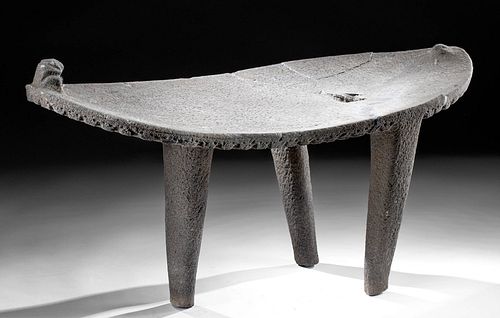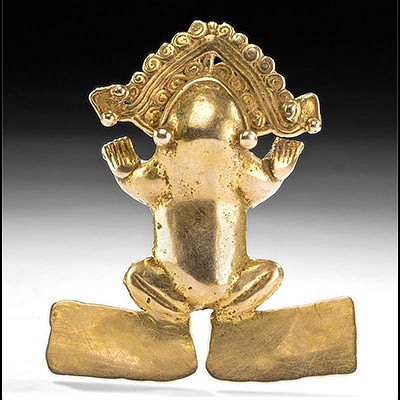Huge Costa Rican Stone Metate w/ Zoomorph
Lot 108d
About Seller
Artemis Fine Arts
686 S Taylor Ave, Ste 106
Louisville, CO 80027
United States
Selling antiquities, ancient and ethnographic art online since 1993, Artemis Gallery specializes in Classical Antiquities (Egyptian, Greek, Roman, Near Eastern), Asian, Pre-Columbian, African / Tribal / Oceanographic art. Our extensive inventory includes pottery, stone, metal, wood, glass and textil...Read more
Estimate:
$4,000 - $6,000
Absentee vs Live bid
Two ways to bid:
- Leave a max absentee bid and the platform will bid on your behalf up to your maximum bid during the live auction.
- Bid live during the auction and your bids will be submitted real-time to the auctioneer.
Bid Increments
| Price | Bid Increment |
|---|---|
| $0 | $25 |
| $300 | $50 |
| $1,000 | $100 |
| $2,000 | $250 |
| $5,000 | $500 |
| $10,000 | $1,000 |
| $20,000 | $2,500 |
| $50,000 | $5,000 |
| $100,000 | $10,000 |
| $200,000 | $20,000 |
About Auction
By Artemis Fine Arts
Aug 13, 2020
Set Reminder
2020-08-13 10:00:00
2020-08-13 10:00:00
America/New_York
Bidsquare
Bidsquare : Fine Antiquities, Ethnographic & Fine Art
https://www.bidsquare.com/auctions/artemis-gallery/fine-antiquities-ethnographic-fine-art-5415
Features classical antiquities, ancient and ethnographic art from cultures encompassing the globe. Egyptian, Greek, Roman, Etruscan, Near Eastern, Asian, Pre-Columbian, Native American, African / Tribal, Oceanic, Spanish Colonial, Russian, Fine Art, so much more! Artemis Fine Arts info@artemisgallery.com
Features classical antiquities, ancient and ethnographic art from cultures encompassing the globe. Egyptian, Greek, Roman, Etruscan, Near Eastern, Asian, Pre-Columbian, Native American, African / Tribal, Oceanic, Spanish Colonial, Russian, Fine Art, so much more! Artemis Fine Arts info@artemisgallery.com
- Lot Description
Pre-Columbian, Central America, Costa Rica, Atlantic Watershed, ca. 800 to 1200 CE. A beautiful ceremonial metate of a massive size, hand-carved from grey volcanic stone, with an endearing seated zoomorph at one end of the ovoid concave grinding platform. The platform or table is also nicely rendered with a scalloped lower periphery and is supported by three legs. Metate technology initially developed for the purpose of grinding corn; however, metates evolved into meaningful ritual objects over time. More elaborate metates boasting carved zoomorphic imagery like this example were likely used for a chief during ceremonies or possibly for a departed lord to 'sit' during his journey to the afterlife. Size: 32.125" L x 17.75" W x 17.375" H (81.6 cm x 45.1 cm x 44.1 cm)
The many uses of metates in ancient Mesoamerica signify its various symbolic meanings. The metate was created primarily to pulverize certain foodstuffs like seeds, certain varieties of plants, and most importantly maize. Maize has been a life source for ancient Costa Rican peoples for centuries, and its abundance during the harvest season was believed to indicate whether society as a whole would prosper or struggle in the coming months. The wealth of corn was also suggestive of not only the fertility of the land, but also those who tended to it. The ruler who likely used metates like this example as a throne would essentially be a physical embodiment of the assurance or dread felt within his people of the fertility and thus the survival of their land.
Provenance: collection of the late Alfred E. Stendahl, Stendahl Gallery, Los Angeles, California, USA, acquired prior to 1990
All items legal to buy/sell under U.S. Statute covering cultural patrimony Code 2600, CHAPTER 14, and are guaranteed to be as described or your money back.
A Certificate of Authenticity will accompany all winning bids.
We ship worldwide and handle all shipping in-house for your convenience.
#126391Repaired from about six pieces with some losses near break lines and around the perimeter of the platform as shown. Small chips and abrasions to grinding platform and legs, with light encrustations. Nice earthen deposits throughout.Condition
- Shipping Info
-
All shipping is handled in-house for your convenience. Your invoice from Artemis Gallery will include shipping calculation instructions. If in doubt, please inquire BEFORE bidding for estimated shipping costs for individual items.
-
- Buyer's Premium



 EUR
EUR CAD
CAD AUD
AUD GBP
GBP MXN
MXN HKD
HKD CNY
CNY MYR
MYR SEK
SEK SGD
SGD CHF
CHF THB
THB















